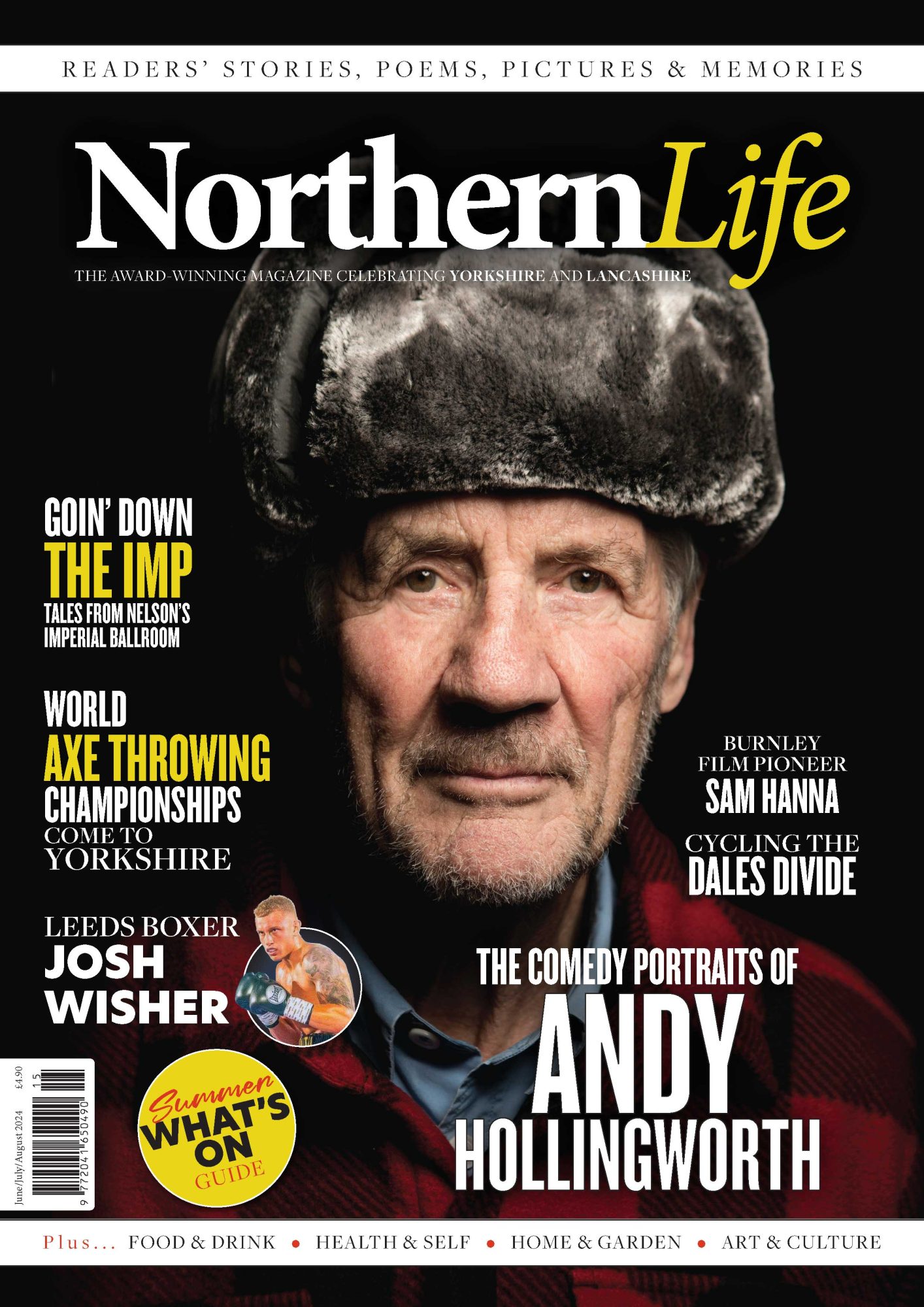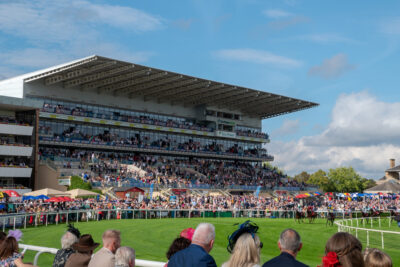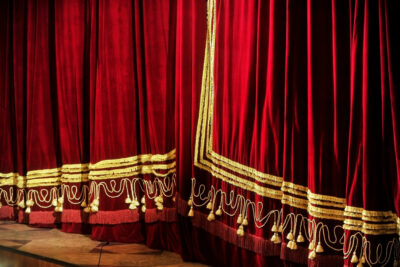
The Name’s Bond, Lawrie Bond
by Andrew Liddle
NICK WOTHERSPOON TALKS TO ANDREW LIDDLE ABOUT HIS PASSION FOR BOND CARS BUILT IN PRESTON
Mention Bond Cars and most people summon up images of Ian Fleming’s superspy at the wheel of a silver-grey Aston Martin. A few, alternatively, might think of the lurid orange Bond Bug, a motoring icon of the 1970s.
We must remember James Bond only came to public consciousness when Dr No, starring Sean Connery, came out in 1962. Indeed Agent 007 had remained under cover until 1953 when he made his print debut in Casino Royale. Lawrie Bond, on the other hand, had been cutting a dashing figure on the racing circuit since the mid-1940s.
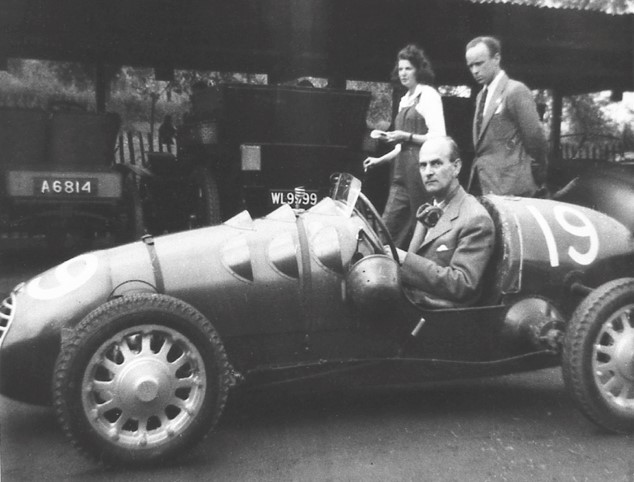
Lawrie Bond in his “Type C” 500cc Racing Car at the Shelsley Walsh Speed Hill Climb, Worcestershire, in 1951.
Did Fleming in any way base his Bond on the flamboyant Preston-born racing driver and aero engineer who was married to a wealthy socialite – or appropriate his surname?
Nick Wotherspoon, a lifelong classic car enthusiast and author of two books on Bond cars, is the best person to ask. A data analyst by profession, he smiles and shrugs. “He was certainly very well known, often seen on Pathé newsreels and would turn up at races impeccably dressed, at the wheel of a military vehicle.”
Certainly, Bond has a good ring to it and was adopted by Sharp’s Commercials Ltd, when they officially became Bond Cars Ltd in 1965. This was the Preston firm that for two decades specialised in producing cheap, light-weight three-wheelers, Minicars and Minitrucks and were happy to use the advertising slogan, ‘My word is my Bond!’
“Lawrie Bond was a restless genius,” Nick says. “He always had several creative projects on the go. Not all were successful, or even finished. He was always tweaking his ideas, would never let well alone. He blew most of his money on building racing cars for his own enjoyment.”
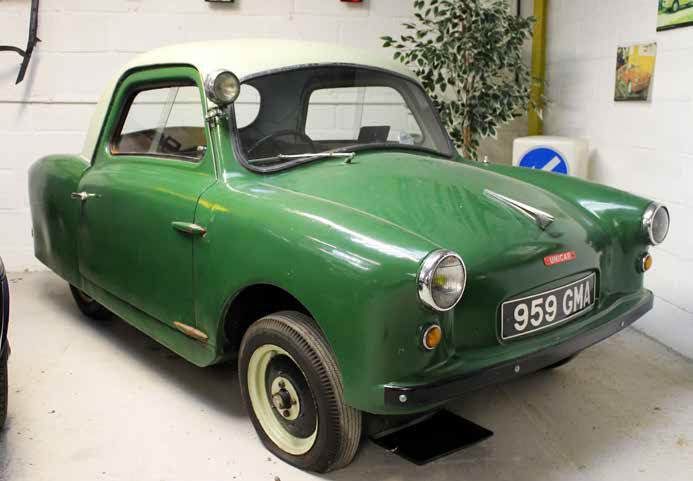
The Opperman Unicar – Initially sold as “the cheapest car available” at the 1956 London Motorshow. Flagging sales and difficulty keeping costs down led to a “build it yourself” kit form version to avoid purchase tax and the vehicle shown started out as just such a kit, completed in 1959.
Born in 1907, Bond attended Preston Grammar School before serving an apprenticeship with the local steam wagon manufacturer, Atkinson & Co. In his early twenties, he worked in Wolverhampton in the drawing office of Henry Meadows Ltd., an engineering firm, before finding employment with Blackburn Aeroplane and Motor Co., at Brough, East Yorkshire.
“Bond was a restless genius. He always had several creative projects on the go. Not all were successful, or even finished.”
By the outbreak of War, he was back in the north-west, in Whiston, Merseyside, now chief engineer and general manager of an aero engine and aircraft component factory. In 1944, he started his own business, the Bond Aircraft & Engineering Co., making aircraft and vehicle components for the Ministry of Supply, with a workshop in Longridge (now commemorated with a blue plaque), just outside Blackpool, with a workforce of 30 and an office on Queen Street.

The Bond 875 launched in 1965 was designed by Lawrie Bond to replace the Bond Minicar – a much more advanced three-wheeler based on Hillman Imp engine and transmission. It had to use a de-tuned version of this engine after John Surtees broke the Brands Hatch lap record test driving a prototype!
Shortly after the War ended Bond came up with a revolutionary idea for a small car. Using his knowledge of aircraft construction, the body was made of aluminium and was powered by a 125cc motorcycle engine. The prototype Bond Minicar was built at Longridge, but these premises were too small for large-scale production so Bond joined Sharp’s Commercials.
“Sharp’s had been refurbishing military vehicles under government contract after the war, but the work was drying up,” Nick explains. “Bond approached them with regard to leasing manufacturing space, but instead the firm’s managing director, Colonel C.R. Gray, took on Bond as designer-consultant and decided to produce the vehicle themselves, after suitable modification and reliability testing.”
“The Bond car was of its time – something within the reach of the ordinary family when cars were not affordable.”
Production began in 1949, with 15 cars a week. The first model was an open-top two-seater tourer with a small amount of luggage space behind the seats. “Early models were entirely aluminium with an aircraftlike monocoque shell. Later, fibreglass mouldings were used for wings and roofs, until the last models were mostly fibreglass.”
“There were no doors fitted, just a curve of the cockpit side to provide a lower section for getting in and out – which was all right when the hood was lowered, but made entry and exit from the vehicle quite a feat when the hood was up.”
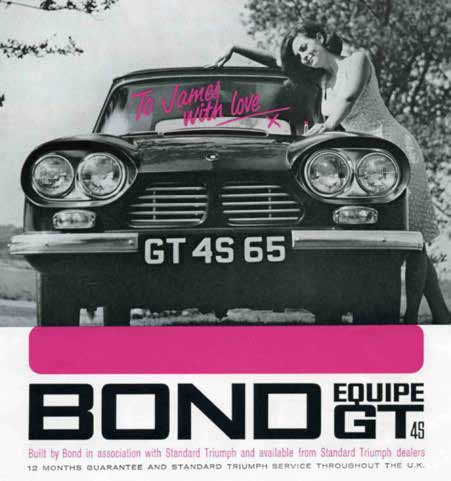
Bond Cars Ltd. Preston launched and improved Equipe model in 1965 – The “GT 4S” – and now began to make references to a “James Bond” name connection in its advertising.
Its great selling point at a time of post-war austerity was its relative cheapness. “The Bond car was of its time,” Nick says, “something within the reach of the ordinary family when cars were not affordable.” Not only was it extremely economical with petrol but, as a three-wheeler, it qualified for a lower rate of purchase tax, and vehicle excise duty and was cheaper to insure.
Without a reverse gear, it could be driven on a motorcycle licence. “It was common at the time for many young men not to progress from a motorcycle to a car licence as there was little chance of affording something with four wheels.”
At the end of 1949, a Deluxe version was added to the range. In 1952, Sharp’s adapted the idea of the Minicar into open-topped lightweight industrial vehicles, the Minivan and the Minitruck. In turn, the Minivan was adapted into the Bond Family Saloon, with room for two children and two adults.
“Three Mark E’s were the first cars to drive along Britain’s first motorway, the Preston By-pass when it opened on 5th December, 1958.”
For the next decade, more sophisticated variants of the family Minicar, with standard and deluxe versions, saloons and tourers, with higher cruising speeds began appearing – culminating in the Mark G, of 1964. Three Mark E’s, incidentally, were the first cars to drive along Britain’s first motorway, the Preston By-pass, when it opened on the morning of 5th December, 1958.
When production eventually came to an end in December 1966, 24 versions of three basic models had been produced.
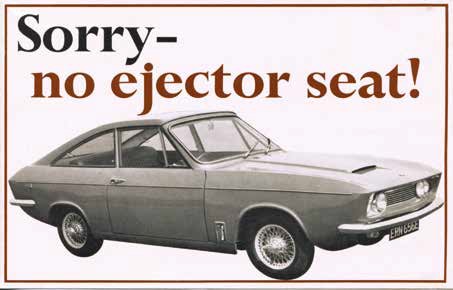
Again the Bond firm made cheeky references in its advertising material for the Equipe 2 Litre launched in August 1967 to a “James Bond” connection!
In the summer of 1953, the ever restless Lawrie Bond had returned to freelance designing, only again to be commissioned by the Preston firm to design their first four-wheeler, the Bond Equipe GT. The attractive two-door four-wheel sports coupé, launched in October 1963, was built with Standard Triumph. Its success led Sharp’s to formally change its name to Bond Cars Limited the following year. “This was one of his most advanced designs, as it also featured a forward-mounted engine layout and uniquely a glass-fibre monocoque shell – two years before the generally accepted first appearance of modern monocoque racing cars with Colin Chapman’s aluminium Lotus 25 Formula One car in 1962.”
In 1965, sadly, Bond turned his back on the car industry and moved to North Yorkshire to run the Bowes Moor Hotel, located on the A66.
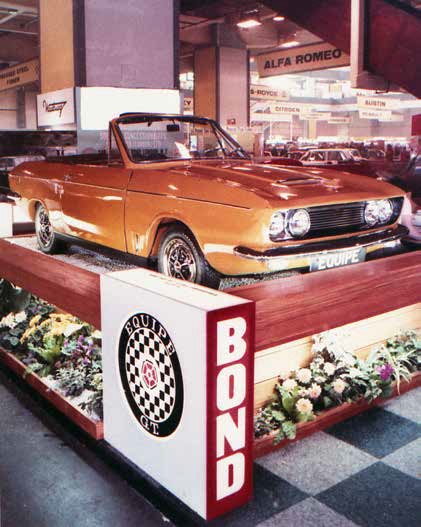
The final model of the Equipe, the 2 Litre MkII Convertible, based on the popular, sporty Triumph Vitesse – seen here on the Bond stand at the 1968 Motorshow.
Although Nick has four cars, two motorbikes and one aeroplane (he’s also Chairman of the British Aviation Archaeological Council), his prize possession is his 1964 Equipe. He sold his first to raise money to buy his future wife, Janet, an engagement ring. “It was sadly written off a couple of years after I managed to buy it back! It then took me 25 years to track down another!”
The most famous car bearing Bond’s name had no connection with him. Wedge-shaped and finished in orange, the Bond Bug – described as futuristic – became a fashion statement in the 1970s. By now, Reliant had taken Sharp’s, and the new three-wheeler had a Reliant four-cylinder engine and a top speed of 75 mph. Its unique feature was that entry was gained by swinging the roof upwards.
“Wedge-shaped and finished in orange, the Bond Bug became something of a fashion statement in the 1970s.”
In 1974, Bond moved to Ansdell, south of Blackpool, to live with his daughter and died shortly afterwards of lung cancer at the age of 67. It was a sad end to the life of a man who had done so much to give wheels to the working man – albeit three rather than four!
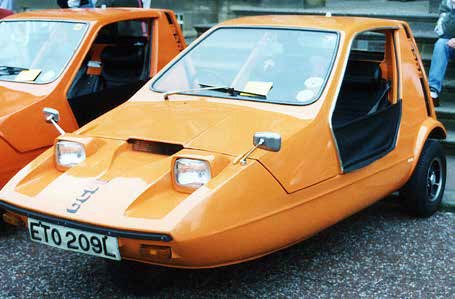
The final vehicle to carry the Bond name – the iconic futuristic “Bond Bug” designed by the late Tom Karen for Reliant and launched in 1970.
“Lawrie Bond was a true pioneer of British popular motoring – at times eccentric, possibly obsessive, but never afraid to try out new ideas. Yet despite his profuse and diverse design output he was until recently largely overlooked,” Nick says with feeling. “I hope my books and other work have at least managed in part to put that right.”
Nick Wotherspoon and his book Lawrie Bond Microcar Man, An Illustrated History of Bond Cars, £13.78, amazon.co.uk
NorthernLife Jan/Feb 24
